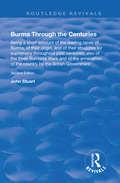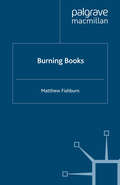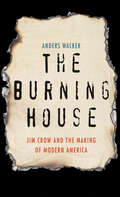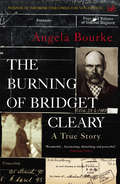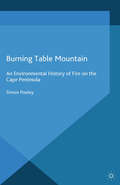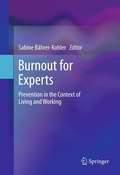- Table View
- List View
Burma/Myanmar: What Everyone Needs to Know® (What Everyone Needs To Know®)
by David SteinbergNo country in Asia in recent years has undergone so massive a political shift in so short a time as Myanmar. Until recently, the former British colony had one of the most secretive, corrupt, and repressive regimes on the planet, a country where Nobel Peace Prize laureate Aung San Suu Kyi was held in continual house arrest and human rights were denied to nearly all. Yet events in Myanmar since the elections of November 2010 have profoundly altered the internal mood of the society, and have surprised even Burmese and seasoned foreign observers of the Myanmar scene. The pessimism that pervaded the society prior to the elections, and the results of that voting that prompted many foreign observers to call them a "sham" or "fraud," gradually gave way to the realization that positive change was in the air. In this updated second edition of Burma/Myanmar: What Everyone Needs to Know®, Davd I. Steinberg addresses the dramatic changes in the country over the past two years, including the establishment of a human rights commission, the release of political prisoners, and reforms in health and education. More than ever, the history, culture, and internal politics of this country are crucial to understanding the current transformation, which has generated headlines across the globe. Geographically strategic, Burma/Myanmar lies between the growing powers of China and India. Yet it is mostly unknown to Westerners despite being its thousand-year history as a nation. Burma/Myanmar is a place of contradictions: a picturesque land with mountain jungles and monsoon plains, it is one of the world's largest producers of heroin. Though it has extensive natural resources including oil, gas, teak, metals, and minerals, it is one of the poorest countries in the world. And despite a half-century of military-dominated rule, change is beginning to work its way through the beleaguered nation, as it moves to a more pluralistic administrative system reflecting its pluralistic cultural and multi-ethnic base. Authoritative and balanced, Burma/Myanmar is an essential book on a country in the throes of historic change. What Everyone Needs to Know® is a registered trademark of Oxford University Press.
Burma Through the Centuries: Being a short account of the leading races of Burma, of their origin, and of their struggles for supremacy throughout past centuries; also of the three Burmese Wars and of the annexation of te country by the British Government (Routledge Revivals)
by J. StuartFirst published in 1909, at the midpoint of British occupation, this volume sought to provide the first popular history of Burma (now Myanmar) for British businessmen and visitors otherwise put off by difficulties of translation and understanding. Having lived in Burma for forty years, arriving between the second and third Anglo-Burmese wars, J. Stuart sought to rectify the reduction of Burmese history to barbarism, comparing the struggle for supremacy between historical Burmese factions to the combined history of France, England and Scotland up to James I. To that end, this volume contains a detailed, chronological history from A.D. 639 until 1900 along with 15 illustrations.
Burma Through the Centuries: Being a short account of the leading races of Burma, of their origin, and of their struggles for supremacy throughout past centuries; also of the three Burmese Wars and of the annexation of te country by the British Government (Routledge Revivals)
by J. StuartFirst published in 1909, at the midpoint of British occupation, this volume sought to provide the first popular history of Burma (now Myanmar) for British businessmen and visitors otherwise put off by difficulties of translation and understanding. Having lived in Burma for forty years, arriving between the second and third Anglo-Burmese wars, J. Stuart sought to rectify the reduction of Burmese history to barbarism, comparing the struggle for supremacy between historical Burmese factions to the combined history of France, England and Scotland up to James I. To that end, this volume contains a detailed, chronological history from A.D. 639 until 1900 along with 15 illustrations.
Burmese Lives: Ordinary Life Stories Under the Burmese Regime
This volume explores the life stories of ordinary Burmese by drawing on the narratives of individual subjects and using an array of interdisciplinary approaches, covering anthropology, history, literature, ethnomusicology, economics and political science. Burma is one of the most diverse societies in Southeast Asia in terms of its ethnic composition. It has a long history of resistance from the public realm against colonial rule and post-independence regimes. However, its isolation for decades before 1988 deprived scholars of a close look into the many faces of this society. Looking into the life stories of members of several major ethnic communities, who hail from different occupations and are of different ages and genders, this book has a particular significance that would help reveal the multiplicities of Burma's modern history. The authors of this volume write about stories of their long-term informants, close friends, family members, or even themselves to bring out a wide range of issues relating to migration, economy, politics, religion and culture. The constituted stories jointly highlight the protagonists' survival strategies in everyday life that demonstrate their constant courage, pain and frustration in dealing with numerous social injustices and adversities. Through these stories, we see movement of lives as well as that of Burmese society.
Burmese Supernaturalism
by Melford E. SpiroThough the people of Burma, now called Myanmar, are formally Buddhist, their folk religion a type of animism or supernaturalism is so unlike classical Buddhism that it seems contradictory. For years scholars of religion and anthropology have debated the questions: Do these folk beliefs make up a separate religious system? Or is there a subtle merging of supernaturalism and Buddhism, a kind of syncretism? In either case, how exactly does folk religion fit into the overall religious pattern? Melford Spiro's Burmese Supernaturalism has been one of the major works in this debate, both for its position on the "two religions" question and for its arguments concerning the psychological basis of religion.The book begins with an introduction to the study of supernaturalism. The next section of the work covers various types of supernaturalism, including witches, ghost, and demons. Other areas of discussion include supernaturally caused illness and its treatment, the shaman, the exorcist, and the relationship between supernaturalism and Buddhism.In the introduction to this expanded edition Spiro further develops the underlying logic of his argument and evaluates the most recent contributions to the field of the anthropology of religion. Burmese Supernaturalism is an intriguing study and will provide insightful reading for anthropologists, sociologists, theologians, as well as those interested in supernaturalism in Burma (Myanmar) and other cultures.
Burmese Supernaturalism
by Melford E. SpiroThough the people of Burma, now called Myanmar, are formally Buddhist, their folk religion a type of animism or supernaturalism is so unlike classical Buddhism that it seems contradictory. For years scholars of religion and anthropology have debated the questions: Do these folk beliefs make up a separate religious system? Or is there a subtle merging of supernaturalism and Buddhism, a kind of syncretism? In either case, how exactly does folk religion fit into the overall religious pattern? Melford Spiro's Burmese Supernaturalism has been one of the major works in this debate, both for its position on the "two religions" question and for its arguments concerning the psychological basis of religion.The book begins with an introduction to the study of supernaturalism. The next section of the work covers various types of supernaturalism, including witches, ghost, and demons. Other areas of discussion include supernaturally caused illness and its treatment, the shaman, the exorcist, and the relationship between supernaturalism and Buddhism.In the introduction to this expanded edition Spiro further develops the underlying logic of his argument and evaluates the most recent contributions to the field of the anthropology of religion. Burmese Supernaturalism is an intriguing study and will provide insightful reading for anthropologists, sociologists, theologians, as well as those interested in supernaturalism in Burma (Myanmar) and other cultures.
Burn It Down: Women Writing about Anger
by Lilly DancygerA rich, nuanced exploration of women's anger from a diverse group of writersWomen are furious, and we're not keeping it to ourselves any longer. We're expected to be composed and compliant, but in a world that would strip us of our rights, disparage our contributions, and deny us a seat at the table of authority, we're no longer willing to quietly seethe behind tight smiles.We're ready to burn it all down. In this ferocious collection of essays, twenty-two writers explore how anger has shaped their lives: author of the New York Times bestseller The Empathy Exams Leslie Jamison confesses that she used to insist she wasn't angry -- until she learned that she was; Melissa Febos, author of the Lambda Literary Award-winning memoir Abandon Me, writes about how she discovered that anger can be an instrument of power; editor-in-chief of Bitch Media Evette Dionne dismantles the "angry Black woman" stereotype; and more. Broad-ranging and cathartic, Burn It Down is essential reading for any woman who has scorched with rage -- and is ready to claim her right to express it.
Burning Books
by M. FishburnThis provocative new work examines the years between the Nazi book fires and the publication of Ray Bradbury's Fahrenheit 451 (1953), a period when book burning captured the popular imagination. It explores how embedded the myths of book burning have become in our cultural history, and illustrates the enduring appeal of a great cleansing bonfire.
Burning Down The House: Recycling Domesticity
by Rosemary Marangoly GeorgeThis book views domesticity through multiple frames and surveys the rhetoric and practices of domestication in contemporary cultures. It also examines the consequences and costs of homemaking in various geographic and textual locations.
Burning Down The House: Recycling Domesticity
by Rosemary Marangoly GeorgeThis book views domesticity through multiple frames and surveys the rhetoric and practices of domestication in contemporary cultures. It also examines the consequences and costs of homemaking in various geographic and textual locations.
Burning Down the House: Latin American Comics in the 21st Century. (Global Perspectives in Comics Studies)
by Laura Cristina Fernández Amadeo Gandolfo Pablo TurnesBurning Down the House explores the political, economic and cultural landscape of 21st-century Latin America through comics. It examines works from Argentina, Brazil, Bolivia, Chile, Uruguay, Perú, Colombia, México and Spain, and the resurgence of comics in recent decades spurred by the ubiquity of the Internet and reminiscent of the complex political experiences and realities of the region. The volume analyses experimentations in themes and formats and how Latin American comics have become deeply plural in its inspirations, subjects, drawing styles and political concerns while also underlining the hybrid and diverse cultures they represent. It examines the representative and historical images in a state of emergency and political upheaval; decolonial perspectives and social struggles linked to ethnic and sexual minorities. It looks at how Latin American comics are made right now – from a diverse and autochthonous Latin American perspective. With a wide array of illustrations, this book in the Global Perspectives in Comics Studies series will be an important resource for scholars and researchers of comic studies, Latin American studies, cultural studies, English literature, political history and post-colonial studies.
Burning Down the House: Latin American Comics in the 21st Century. (Global Perspectives in Comics Studies)
by Laura Cristina Fernández Amadeo Gandolfo Pablo TurnesBurning Down the House explores the political, economic and cultural landscape of 21st-century Latin America through comics. It examines works from Argentina, Brazil, Bolivia, Chile, Uruguay, Perú, Colombia, México and Spain, and the resurgence of comics in recent decades spurred by the ubiquity of the Internet and reminiscent of the complex political experiences and realities of the region. The volume analyses experimentations in themes and formats and how Latin American comics have become deeply plural in its inspirations, subjects, drawing styles and political concerns while also underlining the hybrid and diverse cultures they represent. It examines the representative and historical images in a state of emergency and political upheaval; decolonial perspectives and social struggles linked to ethnic and sexual minorities. It looks at how Latin American comics are made right now – from a diverse and autochthonous Latin American perspective. With a wide array of illustrations, this book in the Global Perspectives in Comics Studies series will be an important resource for scholars and researchers of comic studies, Latin American studies, cultural studies, English literature, political history and post-colonial studies.
The Burning House: Jim Crow and the Making of Modern America
by Anders WalkerA startling and gripping reexamination of the Jim Crow era, as seen through the eyes of some of the most important American writers In this dramatic reexamination of the Jim Crow South, Anders Walker demonstrates that racial segregation fostered not simply terror and violence, but also diversity, one of our most celebrated ideals. He investigates how prominent intellectuals like Robert Penn Warren, James Baldwin, Eudora Welty, Ralph Ellison, Flannery O’Connor, and Zora Neale Hurston found pluralism in Jim Crow, a legal system that created two worlds, each with its own institutions, traditions, even cultures. The intellectuals discussed in this book all agreed that black culture was resilient, creative, and profound, brutally honest in its assessment of American history. By contrast, James Baldwin likened white culture to a “burning house,” a frightening place that endorsed racism and violence to maintain dominance. Why should black Americans exchange their experience for that? Southern whites, meanwhile, saw themselves preserving a rich cultural landscape against the onslaught of mass culture and federal power, a project carried to the highest levels of American law by Supreme Court justice and Virginia native Lewis F. Powell, Jr. Anders Walker shows how a generation of scholars and judges has misinterpreted Powell’s definition of diversity in the landmark case Regents v. Bakke, forgetting its Southern origins and weakening it in the process. By resituating the decision in the context of Southern intellectual history, Walker places diversity on a new footing, independent of affirmative action but also free from the constraints currently placed on it by the Supreme Court. With great clarity and insight, he offers a new lens through which to understand the history of civil rights in the United States.
Burning Matters: Life, Labor, and E-Waste Pyropolitics in Ghana (Global and Comparative Ethnography)
by Peter C. LittleGlobal trade in electronic waste (e-waste) has led to various waste management challenges and many regions of the Global South have suffered the toxic consequences. In Burning Matters, Peter C. Little explores the complex cultural, economic, and environmental health politics of e-waste work in Ghana. He brings to light the lived experiences of Ghana's e-waste workers, as they navigate the health, social, and economic challenges of highly toxic e-waste labor. In particular, Little engages the experiences of e-waste workers who burn bundles of electrical cables to extract copper, a practice that contaminates bodies and the urban environment and which has attracted international organizations seeking to mitigate risk and find quick tech solutions to this highly toxic e-waste work. A nuanced perspective on e-waste burning and environmental politics in Africa at a time when global e-waste generation and trade is at an all-time high, Burning Matters contends that e-waste interventions devoid of ethnographic perspective and knowledge risk downplaying the vibrant complexities of e-waste itself and the matters of social life and labor that matter most to Ghana's e-waste workers.
Burning Matters: Life, Labor, and E-Waste Pyropolitics in Ghana (Global and Comparative Ethnography)
by Peter C. LittleGlobal trade in electronic waste (e-waste) has led to various waste management challenges and many regions of the Global South have suffered the toxic consequences. In Burning Matters, Peter C. Little explores the complex cultural, economic, and environmental health politics of e-waste work in Ghana. He brings to light the lived experiences of Ghana's e-waste workers, as they navigate the health, social, and economic challenges of highly toxic e-waste labor. In particular, Little engages the experiences of e-waste workers who burn bundles of electrical cables to extract copper, a practice that contaminates bodies and the urban environment and which has attracted international organizations seeking to mitigate risk and find quick tech solutions to this highly toxic e-waste work. A nuanced perspective on e-waste burning and environmental politics in Africa at a time when global e-waste generation and trade is at an all-time high, Burning Matters contends that e-waste interventions devoid of ethnographic perspective and knowledge risk downplaying the vibrant complexities of e-waste itself and the matters of social life and labor that matter most to Ghana's e-waste workers.
The Burning Of Bridget Cleary: A True Story
by Angela BourkeIn 1895 twenty-six-year-old Bridget Cleary disappeared from her house in rural Tipperary. At first, some said that the fairies had taken her into their stronghold in a nearby hill, from where she would emerge, riding a white horse. But then her badly burned body was found in a shallow grave. Her husband, father, aunt and four cousins were arrested and charged, while newspapers in nearby Clonmel, and then in Dublin, Cork, London and further afield attempted to make sense of what had happened.In this lurid and fascinating episode, set in the last decade of the nineteenth century, we witness the collision of town and country, of storytelling and science, of old and new. The torture and burning of Bridget Cleary caused a sensation in 1895 which continues to reverberate more than a hundred years later.Winner of the Irish Times Prize for Non-Fiction
Burning Questions: Essays and Occasional Pieces 2004–2021
by Margaret Atwood** A 2022 Book to Look Forward To in The Times, i, Financial Times, Guardian, Evening Standard, New Statesman, Cosmopolitan and SheerLuxe **From cultural icon Margaret Atwood comes a brilliant collection of essays -- funny, erudite, endlessly curious, uncannily prescient -- which seek answers to Burning Questions such as: Why do people everywhere, in all cultures, tell stories?How much of yourself can you give away without evaporating?How can we live on our planet? Is it true? And is it fair?What do zombies have to do with authoritarianism?In over fifty pieces Atwood aims her prodigious intellect and impish humour at our world, and reports back to us on what she finds. The roller-coaster period covered in the collection brought an end to the end of history, a financial crash, the rise of Trump and a pandemic. From debt to tech, the climate crisis to freedom; from when to dispense advice to the young (answer: only when asked) to how to define granola, we have no better questioner of the many and varied mysteries of our human universe. 'Brilliant and funny' Joan Didion'She's taken our times and made us wise to them' Ali Smith'Lights a fire from the fears of our age . . . Miraculously balances humor, outrage, and beauty' New York Times Book Review'All over the reading world, the history books are being opened to the next blank page and Atwood's name is written at the top of it' Anne Enright, Guardian'The outstanding novelist of our age' Sunday Times
Burning Table Mountain: An Environmental History of Fire on the Cape Peninsula (Palgrave Studies in World Environmental History)
by S. PooleyCape Town's iconic Table Mountain and the surrounding peninsula has been a crucible for attempts to integrate the social and ecological dimensions of wild fire. This environmental history of humans and wildfire outlines these interactions from the practices of Khoikhoi herders to the conflagrations of January 2000. The region's unique, famously diverse fynbos vegetation has been transformed since European colonial settlement, through urbanisation and biological modifications, both intentional (forestry) and unintentional (biological invasions). In all the diverse visions people have formed for Table Mountain, aesthetic and utilitarian, fire has been regarded as a central problem. This book shows how scientific understandings of fire in fynbos developed slowly in the face of strong prejudices. Human impacts were intensified in the twentieth century, which provides the temporal focus for the book. The disjunctures between popular perception, expert knowledge, policy and management are explored, and the book supplements existing short-term scientific data with proxies on fire incidence trends recovered from historical records.
Burning Women: Widows, Witches, and Early Modern European Travelers in India (Early Modern Cultural Studies 1500–1700)
by P. BanerjeeIn early modern Europe, the circulation of visual and verbal transmissions of sati, or Hindu widow burning, not only informed responses to the ritualized violence of Hindu culture, but also intersected in fascinating ways with specifically European forms of ritualized violence and European constructions of gender ideology. European accounts of women being burned in India uncannily commented on the burnings of women as witches and criminal wives in Europe. When Europeans narrated their accounts of sati, perhaps the most striking illustration of Hindu patriarchal violence, they did not specifically connect the act of widow burning to a corresponding European signifier: the gruesome ceremonial burnings of women as witches. In examining early modern representations of sati, the book focuses specifically on those strategies that enabled European travellers to protect their own identity as uniquely civilized amidst spectacular displays of 'Eastern barbarity'.
Burnout Among Social Workers
by David F GillespieThe phenomenon of burnout first became the subject of public attention in the mid-1970s. This landmark volume is one of the first devoted exclusively to theoretical and empirical work on burnout. Each valuable chapter represents the state of the art in social services research on burnout. Burnout Among Social Workers illustrates and assesses problems with definitions and theoretical orientations to help clarify the overall conceptual vagueness that has plagued burnout research since its beginning. Attention is paid to both personal and job-related variables and coping mechanisms. Expert social work academicians and researchers clearly demonstrate the importance of burnout measurement for theory and practice and establish important guidelines for subsequent research and theory development in this area.
Burnout Among Social Workers
by David F GillespieThe phenomenon of burnout first became the subject of public attention in the mid-1970s. This landmark volume is one of the first devoted exclusively to theoretical and empirical work on burnout. Each valuable chapter represents the state of the art in social services research on burnout. Burnout Among Social Workers illustrates and assesses problems with definitions and theoretical orientations to help clarify the overall conceptual vagueness that has plagued burnout research since its beginning. Attention is paid to both personal and job-related variables and coping mechanisms. Expert social work academicians and researchers clearly demonstrate the importance of burnout measurement for theory and practice and establish important guidelines for subsequent research and theory development in this area.
Burnout, Fatigue, Exhaustion: An Interdisciplinary Perspective on a Modern Affliction
by Sighard Neckel Anna Katharina Schaffner Greta WagnerThis interdisciplinary book explores both the connections and the tensions between sociological, psychological, and biological theories of exhaustion. It examines how the prevalence of exhaustion – both as an individual experience and as a broader socio-cultural phenomenon – is manifest in the epidemic rise of burnout, depression, and chronic fatigue. It provides innovative analyses of the complex interplay between the processes involved in the production of mental health diagnoses, socio-cultural transformations, and subjective illness experiences. Using many of the existing ideologically charged exhaustion theories as case studies, the authors investigate how individual discomfort and wider social dynamics are interrelated. Covering a broad range of topics, this book will appeal to those working in the fields of psychology, sociology, medicine, psychiatry, literature, and history.
Burnout, Fatigue, Exhaustion: An Interdisciplinary Perspective on a Modern Affliction
by Sighard Neckel Anna Katharina Schaffner Greta WagnerThis interdisciplinary book explores both the connections and the tensions between sociological, psychological, and biological theories of exhaustion. It examines how the prevalence of exhaustion – both as an individual experience and as a broader socio-cultural phenomenon – is manifest in the epidemic rise of burnout, depression, and chronic fatigue. It provides innovative analyses of the complex interplay between the processes involved in the production of mental health diagnoses, socio-cultural transformations, and subjective illness experiences. Using many of the existing ideologically charged exhaustion theories as case studies, the authors investigate how individual discomfort and wider social dynamics are interrelated. Covering a broad range of topics, this book will appeal to those working in the fields of psychology, sociology, medicine, psychiatry, literature, and history.
Burnout for Experts: Prevention in the Context of Living and Working
by Sabine Bährer-KohlerWherever people are working, there is some type of stress—and where there is stress, there is the risk of burnout. It is widespread, the subject of numerous studies in the U.S. and abroad. It is also costly, both to individuals in the form of sick days, lost wages, and emotional exhaustion, and to the workplace in terms of the bottom line. But as we are now beginning to understand, burnout is also preventable. Burnout for Experts brings multifaceted analysis to a multilayered problem, offering comprehensive discussion of contributing factors, classic and less widely perceived markers of burnout, coping strategies, and treatment methods. International perspectives consider phase models of burnout and differentiate between burnout and related physical and mental health conditions. By focusing on specific job and life variables including workplace culture and gender aspects, contributors give professionals ample means for recognizing burnout as well as its warning signs. Chapters on prevention and intervention detail effective programs that can be implemented at the individual and organizational levels. Included in the coverage: · History of burnout: a phenomenon.· Personal and external factors contributing to burnout.· Depression and burnout· Assessment tools and methods.· The role of communication in burnout prevention.· Active coping and other intervention strategies. Skillfully balancing scholarship and accessibility, Burnout for Experts is a go-to resource for health psychologists, social workers, psychiatrists, and organizational, industrial, and clinical psychologists.
Burnout in Social Work Field Education: Mitigating the Risk (SpringerBriefs in Social Work)
by Mary Powell Linda Riggs MayfieldThis book informs social work students about the context and potential for burnout in their field experience, their first work with clients, and equips them to recognize, prevent, and address it. With its emphasis on role ambiguity and self-care based on current research, the volume uniquely fills the gap in available texts and prepares them for successful professional practice with personal mental health. Job burnout and self-care have received attention in research and education in social work and other caring professions, but social work students must successfully complete managed learning assignments in the field before they can become social workers, and those experiences can put the student at risk for burnout. Until very recently, however, student burnout has been a 'silent' issue in the profession and the literature. With this compact book, readers learn the risks of burnout in field assignments for students and new professionals, the organizational andpersonal factors that contribute to it, appropriate self-care strategies to reduce its incidence, and effective coping strategies to limit its effect. Stakeholders gain understanding about burnout incidence, prevention, and self-care that prepares them to take appropriate preventive and prescriptive action. Burnout in Social Work Field Education: Mitigating the Risk is a timely and essential resource for social work instructors, students, field interns, instructors, and supervisors. It can serve as a supplementary text to aid students in understanding what factors will increase their risk of burnout and help them identify which coping strategies are most likely to be effective, based on research. It is a highly desirable complementary text for adoption in social work courses and in-service education in early social work practice. The book also should interest administrators in social service agencies and presenters of in-service education opportunities for social workers and social work educators.

